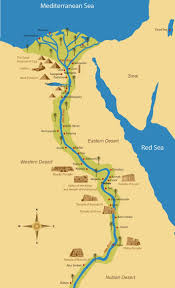Nile River of Ancient Egypt
Nile River of Ancient Egypt
Nile river
The nile river flows over 6,six hundred kilometers (4,a hundred miles) till emptying into the mediterranean sea. For hundreds of years, the river has furnished a source of irrigation to transform the dry location round it into lush agricultural land. These days, the river maintains to function a supply of irrigation, as well as an critical transportation and trade route.
In egypt;
Underneath the aswan high dam, at the northern restriction of lake nasser, the nile resumes its historical path.
North of cairo, the nile splits into branches (or distributaries) that feed the mediterranean: the rosetta department to the west and the damietta to the east, forming the nile delta.
Sediment transport
Nile delta from area
The yearly sediment shipping via the nile in egypt has been quantified.
At aswan: zero.14 million tonnes of suspended sediment and an extra 28% of bedload
At qena: 0.27 million tonnes of suspended sediment and an additional 27% of bedload
At sohag: 1.Five million tonnes of suspended sediment and an extra 13% of bedload
At beni sweif: zero.5 million tonnes of suspended sediment and an extra 20% of bedload
Ancient niles
Is the nile river historic?
The world's longest river, placed in egypt, the nile flows four,132 miles (6,650 kilometres) northward to the mediterranean sea (a very unusual path for a river to take). It was taken into consideration the supply of existence by using the historical egyptians and has performed a important role in the usa's history.
The maximum vital element the nile provided to the historical egyptians was fertile land. Maximum of egypt is wasteland, but along the nile river the soil is rich and right for developing plants. The three maximum important plants were wheat, flax, and papyrus. ... Papyrus - papyrus become a plant that grew along the seashores of the nile.
The present nile has 5 earlier levels; the higher miocenian eonile, of about 6 million years bp,[53][7] the upper pliocenian paleonile, starting up approximately three.32 million years bp, and at some stage in the pleistocene, the nile phases proto-, commencing approximately 600'000 years bp, pre-,[54] transitioning at approximately 400'000 years bp to the[53] neo-.[54] flowing north from the ethiopian highlands, satellite tv for pc imagery became used to discover dry watercourses inside the desolate tract to the west of the nile. A canyon, now crammed by surface drift, represents the eonile that flowed throughout 23–five.3 million years before present. The eonile transported clastic sediments to the mediterranean; several natural gas fields were determined inside those sediments.
At some stage in the past due-miocene messinian salinity disaster, whilst the mediterranean sea became a closed basin and evaporated to the factor of being empty or nearly so, the nile cut its path all the way down to the new base level until it was numerous hundred metres below international ocean level at aswan and 2,400 m (7,900 ft) under cairo. This created a very long and deep canyon which was full of sediment after the mediterranean become recreated. At some point the sediments raised the riverbed sufficiently for the river to overflow westward right into a melancholy to create lake moeris.
Lake tanganyika tired northwards into the nile till the virunga volcanoes blocked its direction in rwanda. The nile changed into an awful lot longer at that time, with its furthest headwaters in northern zambia.
The currently present nile turned into first flowing at some point of the former parts of the wurm glacial period.









No comments: